Boeing 747-400
| Boeing 747-400 | |
|---|---|
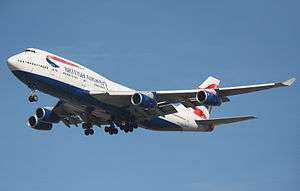 | |
| Boeing 747-400 of British Airways, the type's largest operator | |
| Role | Wide-body jet airliner |
| National origin | United States |
| Manufacturer | Boeing Commercial Airplanes |
| First flight | April 29, 1988 |
| Introduction | February 9, 1989 with Northwest Airlines |
| Status | In service |
| Primary users | British Airways China Airlines Korean Air United Airlines |
| Produced | Passenger versions: 1988–2005[1] Freighter versions: 1993–2009 |
| Number built | 694[2] |
| Unit cost | |
| Developed from | Boeing 747-300 |
| Variants | Boeing YAL-1 Boeing 747 Large Cargo Freighter |
| Developed into | Boeing 747-8 |
The Boeing 747-400 is a major development and the best-selling model of the Boeing 747 family of jet airliners. While retaining the four-engine wide-body layout of its predecessors, the 747-400 embodies numerous technological and structural changes to produce a more efficient airframe. Its most distinguishing features versus preceding 747 models are 6-foot (1.8 m) winglets mounted on 6-foot (1.8 m) wing tip extensions, which are found on all 747-400s except for Japanese domestic market versions.
The 747-400 is equipped with a two-crew glass cockpit, which dispenses with the need for a flight engineer, along with more fuel-efficient engines, an optional fuel tank in the horizontal stabilizer, and revised fuselage/wing fairings. The aircraft also features an all-new interior with upgraded in-flight entertainment architecture. As on the 747-300, passenger variants include a stretched upper deck as standard. The model has a maximum capacity of 660 passengers with the 747-400D variant,[4] and can fly non-stop for up to 7,670 nautical miles (14,200 km) with maximum payload, depending on model.
Northwest Airlines first placed the 747-400 in commercial service in February 9, 1989. The 747-400 was produced in passenger (−400), freighter (−400F), combi (−400M), domestic (−400D), extended range passenger (−400ER) and extended range freighter (−400ERF) versions. The last 747−400, a -400ERF, was delivered in 2009.[5] The 747-400 is the second-most recent version of the Boeing 747 family, having been superseded by the improved Boeing 747-8.
Development
Background
Following its introduction in 1969, the Boeing 747 became a major success with airlines and the flying public.[6] As the world's first wide-body jetliner, the 747 had revolutionized air travel, and cemented its manufacturer's dominance in the passenger aircraft market.[7] In 1980, Boeing announced the 747-300, its latest 747 variant featuring greater passenger capacity. This was made possible by making a stretched upper deck (SUD), previously an option on the 747-200, a standard feature.[8] The SUD was almost twice as long as the original 747 upper deck. Besides increased capacity, the 747-300 did not offer any increase in range, nor did it include improvements in flight deck technology or construction materials.[9] At the same time, 747s were becoming more costly to operate due to a number of factors, notably conventional flight control systems, three-person flight crews, and fuel costs.[6]
In 1982, Boeing introduced a two-crew glass cockpit, new engines, and advanced materials on its 757 and 767 twinjets.[9] Similar technologies were also included in the design plans for newly announced rival wide-body aircraft, namely the Airbus A340 and McDonnell Douglas MD-11.[9] At the same time, combined sales of the 747-100, −200, and −300 models (collectively referred to as the 747 "Classics") neared 700, but new orders slowed precipitously.[10] The introduction of the 747-300 did little to stem the decline, and itself faced potential competition from more modern designs. As a result, Boeing began considering a more significant upgrade for its largest passenger jet.[9]
By early 1984, company officials had identified five development objectives for the latest 747 upgrade: new technologies, an enhanced interior, a 1,000 nautical miles (1,900 km) range increase, more efficient engines, and a 10 percent reduction in operating cost.[9] In September 1984, Boeing announced development of the newest 747 derivative, the "Advanced Series 300", at the Farnborough Airshow.[9] On October 22, 1985, the type was officially launched when Northwest Airlines became the first 747-400 customer, with an order for 10 aircraft.[11] Cathay Pacific, KLM, Lufthansa, Singapore Airlines, and British Airways also announced orders several months later, followed by United Airlines, Air France, and Japan Airlines.[11]
Design effort
Seven early customers, mainly British Airways, Cathay Pacific, KLM, Lufthansa, Northwest, Qantas, and Singapore Airlines, formed a consultative group to advise Boeing on the 747-400's design process.[12] While the aircraft was planned as a new-technology upgrade, Boeing originally proposed minimal design changes in order to reduce development cost and retain commonality with existing models.[12] The airline consultative group sought more advanced changes, including a two-crew glass cockpit. As a result of airline input, the 747-400's new digital cockpit design featured a hybrid of the cathode-ray tube (CRT) display technologies first employed on the 757 and 767, along with carry-over 747 systems such as its autopilot.[12]
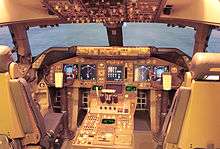
The 747-400's wingspan was stretched by 17 feet (5.2 metres) over the Classic 747 through wingtip extensions. For reduced aerodynamic drag, the wings were fitted with 6 feet (1.8 metres)-tall winglets.[13] Despite the added length, the wings were 6,000 pounds (2,700 kg) lighter as a result of new aluminum alloys.[13] The horizontal tail was also redesigned to fit a 3,300 US gallons (12,000 l) fuel tank, resulting in a 350 nautical miles (650 km) range increase, and the rudder travel was increased to 30 degrees.[13] The landing gear was redesigned with larger wheels and carbon brakes.[13] Internal changes further included a restyled cabin with new materials and updated fittings.[14]
New engines offered on the 747-400 included the Pratt & Whitney PW4056, the General Electric CF6-80C2B1F, and the Rolls-Royce RB211-524G/H.[13] The engines offered lower fuel consumption and greater thrust, along with a full-authority digital engine control (FADEC) which adjusted engine performance for improved efficiency compared with the Classic 747s.[13] A new auxiliary power unit (APU) manufactured by Pratt & Whitney Canada was also selected to provide on-ground power for the 747-400, with a 40 percent reduction in fuel consumption compared to previous APU designs.[13]
Production and testing
Final assembly of the first 747-400 began at Boeing's Everett factory, the longtime site of 747 production, in September 1987.[14] More than fifty percent of the aircraft was produced by subcontractors, with major structures, engine nacelles, and sub-assemblies supplied by Northrop, and upper deck fuselage frames from Daewoo.[15] All components were integrated during the final assembly process at the Everett factory. The first aircraft, equipped with PW4056 engines, was completed over the winter months of late 1987.[14] On January 26, 1988, the first 747-400 rolled out at the Everett factory, while the first 737-400 rolled out at Boeing's Renton factory on the same day, marking the first double jetliner rollout in the manufacturer's history.[14] By the time of the rollout, the 747-400 program had amassed more than 100 orders.[14]
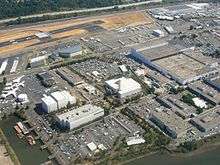
The 747-400 flew for the first time on April 29, 1988, under the command of test pilot James Loesch and co-pilot Kenneth Higgins.[16] The first flight was six weeks behind schedule, owing to subcontractor delays in supplying components, and extra troubleshooting on the aircraft's electronics systems.[14] The maiden flight took off from Paine Field, site of the Everett factory, and landed at Boeing Field, south of Seattle, after an uneventful 2 hours and 26 minutes.[16] The 747-400's flight test program utilized the first four aircraft built, one over the minimum number necessary to certify the aircraft's three engine options.[16] One test aircraft each was fitted with the CF6-80C2B1F and RB21-524G/H engines, while the other two featured PW4056 engines, with the fourth aircraft serving as a backup.[16] Federal Aviation Administration (FAA) certification was received on January 9, 1989 with Pratt & Whitney PW4000 engines, May 18, 1989 with General Electric CF6-80C2s and June 8, 1989 with Rolls-Royce RB211-524Gs.
As the flight test program proceeded, Boeing encountered problems in the 747-400's production process, leading it to disclose delivery delays of up to one month for the first 20 aircraft built.[14] A primary reason for the delays was the unprecedented complexity of interior configurations offered to airlines, which ranged from lavatory and galley locations to the color shades of cabin warning labels.[14] Coupled with new, relatively inexperienced workers, a lack of veteran technicians, interior configurations needing costly re-work, and teething problems with electronics integration on the advanced flight deck, 747-400 production fell behind schedule.[14] The company managed to resolve early production issues by mid-1989, with all three 747-400 engine variants delivered within four months of each other, and overall delays not exceeding several weeks.[14]
Service entry and operations
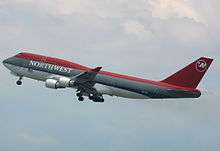
The first 747-400 (N661US) was delivered to launch customer Northwest Airlines on January 26, 1989, with service entry on February 9 with a flight from Minneapolis to Phoenix. This jet then became known for an incident on Northwest Flight 85 caused by a rudder hardover.[17] This was the twentieth anniversary of the 747-100's first flight. On May 31, 1989, Singapore Airlines operated the first international service using a 747-400, on a flight from Singapore to London.[18]
In May 1989, one week before the initial delivery to the 747-400's first European customer, KLM, the Joint Aviation Authorities (JAA) shocked Boeing by refusing to grant regulatory certification for the aircraft, citing the upper deck cabin floor's resistance to collapse in the event of a sudden decompression.[14] While the manufacturer asserted that the 747-400's cabin floor was no different from the already-certified and in-service 747-300, the JAA maintained that the newer model would have a service life into 2020 and beyond and was thus subject to a newer, more stringent standard which had been updated to reflect the risk of explosive devices.[19] In the days leading up to the first delivery to KLM, negotiations between Boeing, the FAA, and the JAA resulted in a compromise: a temporary operating certificate would be issued for the 747-400, provided that the manufacturer develop a structural retrofit for the aircraft within two years.[19] The last-minute deal allowed KLM and Lufthansa to take delivery of their 747-400s without further delays.[19]
After the first 747-400 deliveries, Boeing began production on more variants of the aircraft. The first 747-400 Combi, able to carry both passengers and freight, was rolled out in June 1989.[19] The 747-400 Domestic, a short-range variant of the aircraft designed for Japanese intra-island services, first flew on March 18, 1991 and entered service with Japan Airlines on October 22, 1991. A cargo variant, the 747-400F, was first delivered in May 1993 to Cargolux.[19] By the end of the 1990s, Boeing was producing four versions of the 747-400.
Further developments
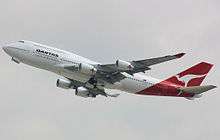
The extended range freighter (ERF) entered service in October 2002. The next month, the extended range (ER) passenger version entered service with Qantas, the only airline ever to order the passenger version of the 747-400ER. Qantas initially used the 747-400ER for the Melbourne to Los Angeles route allowing the completion of the flight with full passenger load and cargo. Prior to the 747-400ER, Qantas would complete such flights by blocking out 'E' zone of the cabin and limiting passenger numbers and cargo. The 747-400ER featured the Boeing Signature Interior, which was later made available on the 747-400 (either as interior refitting on existing 747-400s or factory installation on new frames).
In the 2000s, as part of an effort to promote sustainable and alternative fuel development, as well as lower emissions, several 747-400 operators studied the use of oil extracted from the jatropha plant. Air New Zealand carried out the first commercial flight using jatropha oil for fuel; the airline's 747-400 had one engine burning a mix of 50% jatropha oil and 50% jet fuel for two hours during the flight while engineers collected data. Continental Airlines tested jatropha oil in one of its airliners on January 7, 2009. Jatropha is easy to grow, needs little fertilizer or water, and produces an oil-rich plant.[20]
Production of the 747-400 passenger version officially ceased on March 15, 2007.[1] The last four −400s on order were cancelled by Philippine Airlines (which switched to the 777-300ER). The last to order the −400 was China Airlines in November 2002, with the last passenger 747-400 constructed in 2005 and delivered in April of that year.[1] It was the 1358th 747 (MSN33737/B-18215).[21] The last 747-400 was a -400ERF delivered on December 22, 2009 to Kalitta Air.[5]
Retirement and economic value
The 747-400's leasing, resale and salvage value has dropped steeply because it is relatively expensive to operate. As many 747-400s are now more than 20 years old, airlines are beginning to replace them. Airlines using the 747-400 have accelerated its retirement (as of 2015) and are replacing the model with more fuel efficient aircraft. The main appeal of the 747-400 like its predecessors was its range rather than its capacity, and in many cases it has been replaced by wide-body twin-engine aircraft of similar range such as the Boeing 777 and Boeing 787. The change in emphasis from hub and spoke operations to point-to-point flights has also reduced the need for jumbo jets.[22] Airlines such as British Airways and Qantas who plan to maintain the same capacity on routes currently served by 747-400s have ordered the Airbus 380 rather than the updated 747-8.
For example, Delta Airlines has reduced the number of flights it operates from the United States to Narita International Airport that are intended to transfer passengers to other destinations in Asia. Instead, Delta will utilize twin-engine widebody aircraft operating from an expanded hub at Seattle-Tacoma International Airport.[23] Total capacity will be cut, but consequentially load factors will increase. In April 2015, Delta announced it would accelerate the retirement of its 747-400 aircraft and replace them either with Airbus A330 aircraft reassigned from cancelled international runs, or with new Airbus A350 aircraft now on order. That will leave just six 747s flying for the airline in 2015. Delta could not keep the 747s full without deeply discounting ticket prices; the discounts and increased maintenance required of a four-engine aircraft led to a drag on profits.[24]
Moreover, economic weakness in air cargo markets has slowed demand for cargo conversions. Since the cost of replacing a 747-400 is high (an airline must purchase or lease another wide-body), some operators choose to fly the 747-400 to the conclusion of its accepted useful life and then scrap it. The current parts resale value for this aircraft has been reduced to its engines. When a 26-year-old 747-400 owned by Delta Airlines flew through a violent hailstorm, Delta indicated it was likely the plane would be scrapped. George Dimitroff, head of valuations for FlightGlobal, estimated the aircraft's value before the incident at about $8 million. He noted that this is not the same as its insured value.[25][26]
Several airlines have retired their 747-400 from the trans-pacific market. Remaining operators in 2014 include EVA Air, Qantas, British Airways and United. United is retaining its 23 747-400s for now, but the airline's deployment of them also reflects a change in emphasis from Asian hubs to domestic hubs, meaning that it will have more direct flights from the United States to secondary Asian market cities. This may reduce the need for jumbo jets.[27]
Design

_arrives_London_Heathrow_17Oct2010_arp.jpg)
The 747-400's airframe features extended and lighter wings than previous 747s, capped by winglets. The winglets result in a 3 percent increase in long-range cruise, improved takeoff performance, and higher cruise altitudes.[13] The extended wingspan also gains an additional leading edge flap section.[13] When unfurnished, the basic 747-400 fuselage is lighter than preceding models, but when fitted out it is heavier and stronger than previous models.[28] The landing gear uses the same configuration as previous 747s, but with carbon brakes replacing the previous steel ones, and overall weight savings of 1,800 pounds (820 kg).[28]
The 747-400's glass cockpit features CRT displays which show flight instrumentation along with engine indication and crew alerting system (EICAS) diagnostics.[12] The flight engineer station on previous 747s is no longer installed, and the new displays and simplified layout results in a two-thirds reduction of switches, lights, and gauges versus the Classic 747.[12] Other new systems include an advanced Honeywell flight management computer (FMC) which assists pilots in calculating optimal altitudes and routes along with a Rockwell-Collins central maintenance computer (CMC) which automates troubleshooting tasks.[12]
The redesigned 747-400 interior features new cabin sidewalls, heat-resistant phenolic glass, carbon composite paneling, and larger storage bins.[14] An enhanced in-flight entertainment framework, called the Advanced Cabin Entertainment/Service System (ACESS), debuted on 747-400, which integrates 18-channel audio capability, four passenger intercom announcement zones, inter-cabin telephones, and passenger lighting into a central system.[29] An eight-bunk overhead crew rest is installed above the aft cabin, while a second crew rest area is located on the upper deck behind the cockpit for flight crew use.[29]
The last few 747-400s delivered features the Boeing Signature Interior, derived from the Boeing 777.[30]
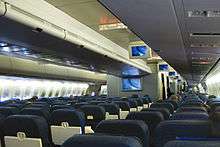
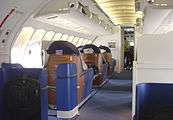

Variants
747-400
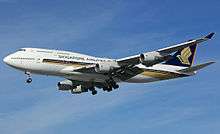
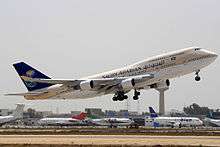
The original variant of the redesigned 747, the 747-400 debuted an increased wingspan, winglets, revised engines, and a glass cockpit which removed the need for a flight engineer. The type also featured the stretched upper deck (SUD) introduced with the 747-300. The passenger model formed the bulk of 747-400s sold, and 442 were built.
In 1989, a Qantas 747-400 flew non-stop from London to Sydney, a distance of 9,720 nmi (11,190 mi, 18,001 km), in 20 hours and 9 minutes to set a commercial aircraft world distance record.[31][32] As of 2014, this is the fastest heavyweight flight between London and Sydney.[33] This was a delivery flight with no commercial passengers or freight on board. During testing, the first 747-400 built also set a world record for the heaviest airliner takeoff on June 27, 1988, on a flight to simulate heavy-weight stalls.[16] The flight had a takeoff weight of 892,450 pounds (404,810 kg), and in order to satisfy Fédération Aéronautique Internationale regulations, the aircraft climbed to a height of 6,562 feet (2,000 m).[16]
747-400F
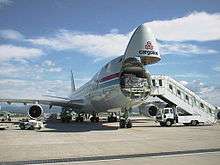
The 747-400F (Freighter) is an all freight version of the 747-400. While using the updated systems and wing design of the passenger versions, it features the original short upper deck found on the classic 747s in order to save weight. The model's first flight was on May 4, 1993, and it entered service with Cargolux on November 17, 1993. Major customers included Atlas Air, Cargolux, China Airlines, Korean Air, Nippon Cargo Airlines, Polar Air Cargo, and Singapore Airlines. The −400F can be easily distinguished from the passenger −400 by its shorter upper-deck hump and lack of windows along the main deck.
The 747-400F has a main deck nose door and a mechanized cargo handling system. The nose door swings up so that pallets or containers up to 40 ft (12 m) can be loaded straight in on motor-driven rollers. An optional main deck side cargo door (like the 747-400M (Combi)) allows loading of dimensionally taller cargo modules. A lower deck ("belly") side door allows loading of unit load devices (ULD) up to 163 cm in height. Boeing delivered 126 Boeing 747-400F aircraft with no unfilled orders as of November 2009.[2] The last −400F was delivered to Nippon Cargo Airlines on August 2, 2008.
747-400M

The 747-400M (a passenger/freight or "Combi" variant) first flew on June 30, 1989 and entered service with KLM on September 12, 1989. Based on the successful Combi versions of the Classic 747s, the −400M has a large cargo door fitted to the rear of the fuselage for freight loading to the aft main deck cargo hold. A locked partition separates the cargo area from the forward passenger cabin, and the −400M also features additional fire protection, a strengthened main deck floor, a roller-conveyor system, and passenger-to-cargo conversion equipment.[34] The last 747-400M was delivered to KLM on April 10, 2002.[17]
747-400D
The 747-400D (Domestic) is a high density seating model developed for short-haul, high-volume domestic Japanese flights. This model is capable of seating a maximum of 568 passengers in a two-class configuration or 660 passengers in a single-class configuration.[4]
The −400D lacks the wingtip extensions and winglets included on other variants. Winglets would provide minimal benefits on short-haul routes, while adding extra weight and cost. The −400D may be converted to the long range version if needed. The 747-400D can be distinguished from the otherwise similar-looking 747-300 by the extra windows on the upper deck. These allow for extra seating at the rear of the upper deck, where a galley would normally be situated on longer flights. In total, 19 of the type were built, with the last example delivered to All Nippon Airways on February 11, 1996.[17] This variant was retired with ANA retiring its last 747 on March 31, 2014.
747-400ER
The 747-400ER (Extended Range) was launched on November 28, 2000 following an order by Qantas for six aircraft.[17] The model was commonly referred to as the '910k' signifying its maximum weight achieved via structural modifications and modified landing gear. This was the only order for the passenger version, chosen by Qantas to allow for full loads between Melbourne and Los Angeles, particularly in the western direction. The −400ER can fly 500 miles (805 km) farther, or carry 15,000 lb (6,800 kg) more freight. The first 747-400ER was used as a test flight airplane and painted in Boeing colours, registration N747ER. Qantas received the first delivery of a 747−400ER Registration VH-OEF on October 31, 2002; this was the second airplane built. The flight test airplane was refurbished and delivered in Qantas livery. The 747-400ER included the option of one or two additional 3,240 US gal (12,300 L) body fuel tanks in the forward cargo hold, however QANTAS was the only customer that ordered the single body tank configuration, and no airplanes were delivered with dual body fuel tanks. Manufactured by Marshall Aerospace, these tanks utilized metal to metal honeycomb-bonded technology to achieve a high fuel volume-to-dry weight ratio. The tanks featured a double wall, integrated venting system, and achieve fuel control via a modified Fuel System Management Card (FSMC) which optimizes fuel transfer into the Center Wing Tank (CWT) in flight along with the fuel transfer from the Horizontal Stabiliser Tank (HST). The tank is removable using tooling that interfaces with the cargo loading system. Similar technology has been used by Marshall in the development of body fuel tanks for the Boeing 777-200LR and Boeing P-8A Poseidon. Other changes to the 747-400ER include relocation of oxygen system components and the potable water system tanks and pumps since the body fuel tanks prevent access to the standard locations.
747-400ERF
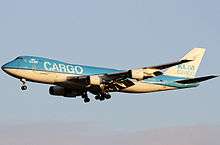
The 747-400ERF (747-400ER Freighter) is the freight version of the −400ER, launched on April 30, 2001.[17] The 747-400ERF is similar to the 747-400F, except for increased gross weight capability which allows it to carry more cargo weight. Unlike the 747-400ER, no customers ordered the optional body (cargo compartment) fuel tanks. The 747-400ERF has a maximum takeoff weight of 910,000 pounds (412,769 kg) and a maximum payload of 248,600 pounds (112,760 kg). It offers cargo airlines the choice of either adding 22,000 pounds (9,980 kg) more payload than other 747-400 freighter variants, or adding 525 nautical miles (972 km) to the maximum range.[35]
The -400ERF has a range of 5,700 miles (9,200 km) with maximum payload, about 326 miles (525 km) farther than the standard 747-400 freighter, and has a strengthened fuselage, landing gear, and parts of its wing, along with new, larger tires. The first −400ERF was delivered to Air France (via ILFC) on October 17, 2002. Boeing has delivered 40 Boeing 747-400ERFs with no outstanding orders.[2] The new 747-8 Freighter has more payload capacity, but less range than the 747-400ERF.
747-400 Boeing Converted Freighter
The 747-400BCF (Boeing Converted Freighter), formerly known as the 747-400SF (Special Freighter), is a conversion program for standard passenger 747-400s. The project was launched in 2004 and will be done by approved contractors such as TAECO, KAL Aerospace and SIA Engineering. The first Boeing 747-400BCF was redelivered to Cathay Pacific Cargo and entered service on December 19, 2005. This kind of converting procedure is located at Xiamen Gaoqi International Airport in China.
The 747-400BDSF (Bedek Special Freighter) is another converted version freighter by Israel Aerospace Industries (IAI). The first 747-400BDSF was redelivered to Air China Cargo. Several Boeing 747-45EM planes from EVA Air have been converted as BDSF model after retiring from passenger service.[36] This kind of converting procedure is located at Ben Gurion International Airport in Tel Aviv, Israel.
Neither the 747-400BCF nor the 747-400BDSF have a nose cargo door; freight can only be loaded through the side cargo door.
747 Large Cargo Freighter

Boeing announced in October 2003 that, because of the amount of time involved with marine shipping, air transport would be the primary method of transporting parts for the Boeing 787 Dreamliner. Pre-owned passenger 747-400 aircraft have been converted into an outsize, "Large Cargo Freighter" (LCF) configuration to ferry sub-assemblies to Everett, Washington for final assembly.[37] The LCF has a bulging fuselage similar to that of the Aero Spacelines Super Guppy or Airbus Beluga cargo aircraft.
The conversion, designed by Boeing engineers from Puget Sound, Moscow and Canoga Park, Cal., and Gamesa Aeronáutica in Spain,[38] was carried out in Taiwan by a subsidiary of the Evergreen Group.[39] Boeing purchased four second-hand aircraft and had them all converted;[40] the fourth and final LCF took its first flight in January 2010.
Delivery times are as low as a day using the 747 LCF, compared to up to 30 days for deliveries by ship.[40] The LCF has the largest cargo hold of any aircraft and can hold three times the volume of a 747-400F freighter.[38][41] The LCF is not a Boeing production model and has not been offered for sale to any customers. The LCFs are intended for Boeing's exclusive use.
Government, military and other variants
- C-33: Proposed U.S. military transport version of the 747-400, intended to augment the Boeing C-17 Globemaster III fleet. The C-33 cost less and had greater range, although it could not use austere runways or handle outsize military equipment and had a higher expected operating cost. The plan was canceled in favor of the purchase of more C-17s.[42]
- YAL-1: "Airborne Laser" carrier based on a 747-400F for the United States Air Force. The aircraft has been heavily modified to carry a nose mounted turret and Chemical Oxygen Iodine Laser (COIL) equipment in order to shoot down ICBMs. Retired to the 309th AMARG at Davis-Monthan AFB, AZ in 2012 after cancellation of the program funding.[43]
- A number of other governments also use the 747-400 as a VIP transport, including Bahrain, Brunei, India, Japan, Oman, Qatar, Saudi Arabia and United Arab Emirates.
- A used Virgin 747-400 will serve as the launcher for Virgin Galactic LauncherOne Air launch to orbit orbital rocket.[44]
- 747-400 Water Bomber: Global Supertankers has converted the 747-400 Freighter for use as an airborne firefighter. The converted water bomber carries 19,600 gallons of water or chemical fire retardant in eight pressurized tanks. The United States Forest Service plans to open discussions about the use of this aircraft in 2017. The 747-400 Water Bomber has not yet received FAA certification as of 2016.[45]
Operators
In October 2016, there is 204 passenger aircraft in service after Cathay Pacific and Air France retired theirs, 172 excluding charters. The largest operators are British Airways with 38, United Airlines with 21 and KLM with 19. It should exit the United fleet by the end of 2018, but British Airways should operate at least 19 747-400s by the end of 2020.[46]
Current operators
As of July 2016, Boeing 747-400s are in service with the following operators:
- Commercial
| Region | Operator | -400 | F | BCF | BDSF | ERF | ER | C | LCF | total |
|---|---|---|---|---|---|---|---|---|---|---|
| Africa | Kabo Air | 1 | 1 | |||||||
| Africa | Max Air | 1 | 1 | |||||||
| Africa | Royal Air Maroc | 1 | 1 | |||||||
| Asia | Air China | 3 | 3 | 6 | ||||||
| Asia | Air Hong Kong | 3 | 3 | |||||||
| Asia | Air India | 4 | 4 | |||||||
| Asia | Asiana Airlines | 2 | 4 | 6 | 2 | 14 | ||||
| Asia | Cargo Air Lines | 1 | 1 | 1 | 3 | |||||
| Asia | Cathay Pacific | 1 | 6 | 7 | ||||||
| Asia | China Airlines | 8 | 18 | 2 | 28 | |||||
| Asia | China Cargo Airlines | 1 | 1 | |||||||
| Asia | China Southern Airlines | 2 | 2 | |||||||
| Asia | El Al | 6 | 1 | 7 | ||||||
| Asia | Etihad Airways | 1 | 1 | |||||||
| Asia | EVA Air | 3 | 3 | 4 | 10 | |||||
| Asia | Garuda Indonesia | 2 | 2 | |||||||
| Asia | Iraqi Airways | 2 | 2 | |||||||
| Asia | Korean Air | 7 | 9 | 8 | 24 | |||||
| Asia | Lion Air | 2 | 2 | |||||||
| Asia | Nippon Cargo Airlines | 5 | 5 | |||||||
| Asia | Orient Thai Airlines | 1 | 1 | |||||||
| Asia | Qantas | 5 | 2 | 6 | 13 | |||||
| Asia | Qatar Airways | 1 | 1 | 2 | ||||||
| Asia | Saudia | 4 | 3 | 6 | 2 | 15 | ||||
| Asia | Singapore Airlines Cargo | 9 | 9 | |||||||
| Asia | Thai Airways International | 10 | 10 | |||||||
| Asia | Yangtze River Express | 3 | 3 | |||||||
| Europe | Aerotranscargo | 2 | 2 | |||||||
| Europe | Air Bridge Cargo | 2 | 2 | 5 | 9 | |||||
| Europe | Air Cargo Global | 1 | 1 | 2 | ||||||
| Europe | ASL Airlines Belgium | 2 | 2 | |||||||
| Europe | British Airways | 39 | 39 | |||||||
| Europe | CargoLogicAir | 1 | 1 | |||||||
| Europe | Cargolux | 6 | 2 | 8 | ||||||
| Europe | Cargolux Italia | 3 | 3 | |||||||
| Europe | Corsair | 3 | 3 | |||||||
| Europe | KLM Royal Dutch Airlines | 5 | 15 | 20 | ||||||
| Europe | Lufthansa | 13 | 13 | |||||||
| Europe | Martinair | 1 | 3 | 4 | ||||||
| Europe | myCargo Airlines | 1 | 1 | |||||||
| Europe | Rossiya | 3 | 3 | |||||||
| Europe | Silk Way West Airlines | 2 | 2 | |||||||
| Europe | Virgin Atlantic Airways | 8 | 8 | |||||||
| Europe | Wamos Air | 3 | 3 | |||||||
| Americas | Atlas Air | 4 | 11 | 1 | 1 | 11 | 28 | |||
| Americas | Centurion Air Cargo | 1 | 3 | 4 | ||||||
| Americas | Conviasa | 1 | 1 | |||||||
| Americas | Delta Air Lines | 9 | 9 | |||||||
| Americas | Kalitta Air | 3 | 6 | 1 | 10 | |||||
| Americas | National Airlines | 2 | 2 | |||||||
| Americas | Polar Air Cargo | 7 | 7 | |||||||
| Americas | United Airlines | 21 | 21 | |||||||
| Americas | UPS Airlines | 11 | 2 | 13 | ||||||
| Americas | Western Global Airlines | 1 | 1 | |||||||
| Region | Operator | -400 | F | BCF | SF | ERF | ER | C | LCF | total |
- Non-commercial
-
 Abu Dhabi Amiri Flight
Abu Dhabi Amiri Flight -
 Dubai Air Wing
Dubai Air Wing -
 Government of Bahrain
Government of Bahrain -
 Government of Kuwait (Kuwait Airways)
Government of Kuwait (Kuwait Airways) -
 Government of Morocco
Government of Morocco -
 Government of Saudi Arabia (Saudia)
Government of Saudi Arabia (Saudia) -
 Japan Air Self-Defense Force
Japan Air Self-Defense Force -
 Kingdom Holding Company
Kingdom Holding Company -
 Republic of Korea Air Force[48]
Republic of Korea Air Force[48] -
 Royal Flight of Oman
Royal Flight of Oman -
 Sultan of Brunei
Sultan of Brunei
Former operators
This list also includes carriers that used the aircraft temporarily, besides main operators.
- Commercial
Deliveries
| Type | Total | 2009 | 2008 | 2007 | 2006 | 2005 | 2004 | 2003 | 2002 | 2001 | 2000 | 1999 | 1998 | 1997 | 1996 | 1995 | 1994 | 1993 | 1992 | 1991 | 1990 | 1989 |
|---|---|---|---|---|---|---|---|---|---|---|---|---|---|---|---|---|---|---|---|---|---|---|
| 747-400 | 440 | 2 | 3 | 6 | 5 | 19 | 9 | 34 | 43 | 30 | 18 | 16 | 32 | 42 | 47 | 48 | 54 | 34 | ||||
| 747-400D | 21 | 2 | 1 | 6 | 8 | 2 | ||||||||||||||||
| 747-400ER | 6 | 3 | 3 | |||||||||||||||||||
| 747-400ERF | 40 | 6 | 6 | 8 | 6 | 2 | 5 | 4 | 3 | |||||||||||||
| 747-400F | 126 | 2 | 8 | 8 | 8 | 9 | 7 | 6 | 15 | 12 | 15 | 10 | 8 | 4 | 3 | 5 | 4 | 2 | ||||
| 747-400M | 63 | 1 | 1 | 3 | 2 | 5 | 5 | 2 | 3 | 6 | 6 | 12 | 8 | 7 | ||||||||
| Total | 694 | 8 | 14 | 16 | 14 | 13 | 15 | 19 | 27 | 31 | 25 | 47 | 53 | 39 | 26 | 25 | 40 | 56 | 61 | 62 | 62 | 41 |
Incidents and accidents
The first hull loss of a 747-400 occurred on November 4, 1993 when China Airlines Flight 605, flying from Taipei to Hong Kong Kai Tak Airport, touched down more than 2,100 feet (640 m) past the runway's displaced threshold during 20 knot (gusting 38) crosswinds. Combined with the disengagement of auto brakes and retracted speed brakes, manual braking and thrust reversal were not enough to prevent the aircraft from sliding into Victoria Harbour. No one was seriously injured, but the aircraft was written off.[50] The type's second hull loss occurred on October 31, 2000, when Singapore Airlines Flight 006, a 747-400 flying on a Singapore to Los Angeles route via Taipei, rammed into construction equipment while attempting to take off from a closed runway at Chiang Kai-shek International Airport. The aircraft caught fire and was destroyed, killing 79 passengers and four crew members.[51] The cause was attributed to the flight crew navigating to the wrong runway.[51]
The 747-400F has recorded 3 hull-loss accidents. On September 3, 2010, UPS Airlines Flight 6 from Dubai International Airport to Cologne Bonn Airport, a 747-400F with two crew members on board, crashed roughly 25 minutes after departure. The crew declared an emergency, apparently due to an in-flight fire, and after abandoning one attempt at landing were unable to see their instruments. The aircraft impacted with the ground at high speed, killing both crew members.[52][53] On July 28, 2011, Asiana Airlines Flight 991, a Boeing 747-400F flying from Incheon Airport to Shanghai Pudong Airport, crashed into the Pacific Ocean off Jeju Island, South Korea, after reportedly suffering mechanical problems due to a possible on-board fire. Two crew members on board were killed.[54] National Airlines Flight 102, a 747-400BCF crashed on April 29, 2013 (the 25th anniversary of the type's first flight) at Bagram Air Base Afghanistan killing 7 crew members. The crash was attributed to a cargo shift of military vehicles to the back of the hold during take-off.[55]
Other incidents involving the 747-400 did not result in irreparable aircraft damage. On December 15, 1989, KLM Flight 867, a 747-400M, en route to Narita International Airport via Anchorage International Airport, flew through a thick cloud of volcanic ash, causing severe damage to the aircraft and replacement of all four engines.[56] On July 23, 1999, a man killed the pilot of All Nippon Airways Flight 61, a 747-400D bound for New Chitose Airport near Sapporo, Hokkaidō from Tokyo International Airport (Haneda), during an attempted hijacking, and was restrained by other crew members; the aircraft landed safely.[57] On September 23, 1999, Qantas Flight 1, flying from Sydney to London via Bangkok, overran the runway after touching down more than 1,000 metres (3,300 ft) from the threshold during a storm with heavy rain, resulting in aircraft damage and minor passenger injuries.[58] On January 31, 2001, the pilot of Japan Airlines Flight 907, a 747-400D bound for Naha International Airport from Tokyo International Airport, made an emergency dive, narrowly avoiding a collision with a Japan Airlines DC-10.[59] On October 9, 2002, Northwest Airlines Flight 85, traveling from Detroit Metropolitan Wayne County Airport to Narita International Airport, made an emergency landing at Anchorage International Airport after a sudden lower rudder hardover.[60] On July 25, 2008, Qantas Flight 30, traveling to Melbourne Airport from Hong Kong International Airport, made an emergency landing at Ninoy Aquino International Airport in Manila, Philippines with a gaping hole in its lower forward fuselage; no one was hurt, and authorities determined that an exploding emergency oxygen supply bottle was the most likely cause.[61][62][63] In June 2015, a Delta Airlines 747-400 was badly damaged by hail while flying to Incheon International Airport, South Korea and taken out of service.[26]
Aircraft on display
- VH-OJA, the first 747-400 delivered to Qantas, is displayed at the Historical Aviation Restoration Society museum at Illawarra Regional Airport in Wollongong, New South Wales, Australia. It is the first 747-400 to be preserved and it holds the record of a longest non stop flight.[64]
- N661US, a former Delta Air Lines example, is on display at the Delta Flight Museum at Hartsfield-Jackson Atlanta International Airport in Atlanta, Georgia.[65][66] The aircraft was the first -400 series built, serving as the prototype (then registered N401PW) prior to delivery to Northwest Airlines in December 1989.
Specifications
| Model | 747-400 | 747-400ER | 747-400F | 747-400ERF |
|---|---|---|---|---|
| Cockpit crew | 2 | |||
| Seating capacity or Cargo capacity | 416 (3-class) or 524 (2-class) 660 (400D, 1-class)[4] | Main deck: 30 pallets Lower deck: 32 LD-1 containers Max. payload: 248,300 lb (112,630 kg) | Main deck: 30 pallets Lower deck: 32 LD-1 containers Max. payload: 248,600 lb (112,760 kg) | |
| Overall length | 231 ft 10 in (70.6 m) | |||
| Wingspan | 211 ft 5 in (64.4 m) | |||
| Wing area | 6027.78 ft² (560 m²) | |||
| Aspect ratio | 7.4 | |||
| Overall height | 63 ft 8 in (19.4 m) | |||
| Operating empty weight (typical) | 394,100 lb (178,800 kg) | 406,900 lb (184,570 kg) | 364,000 lb (165,107 kg) | 362,400 lb (164,382 kg) |
| Maximum take-off weight | 875,000 lb (396,890 kg) | 910,000 lb (412,775 kg) | 875,000 lb (396,890 kg) | 910,000 lb (412,775 kg) |
| Cruising speed at 35,000 feet | Mach 0.85 (567 mph, 493 knots, 912 km/h) | Mach 0.855 (570 mph, 495 kn, 917 km/h) | Mach 0.845 (564 mph, 490 kn, 908 km/h) | |
| Maximum speed at 35,000 ft | Mach 0.92 (608 mph, 528 kn, 978 km/h) | |||
| Takeoff field length (MTOW, SL, ISA) | 3,200 m (10,500 ft) | 3,100 m (10,200 ft) | 3,250 m (10,660 ft) | 3,100 m (10,200 ft) |
| Maximum range with maximum payload | 7,260 nmi (13,450 km)[67] | 7,670 nmi (14,205 km)[67] | 4,445 nmi (8,230 km) | 4,970 nmi (9,200 km) |
| Maximum fuel capacity | 57,285 US gal (216,840 L) | 63,705 US gal (241,140 L) | 57,285 US gal (216,840 L) | |
| Engine models (x 4) | PW 4056 GE CF6-80C2B1F RR RB211-524H | PW 4062 GE CF6-80C2B5F | PW 4062 GE CF6-80C2B5F RR RB211-524H | PW 4062 GE CF6-80C2B5F |
| Engine thrust (x 4) | 63,300 lbf (282 kN) PW 62,100 lbf (276 kN) GE 59,500 lbf (265 kN) RR | 63,300 lbf (282 kN) PW 62,100 lbf (276 kN) GE | 63,300 lbf (282 kN) PW 62,100 lbf (276 kN) GE 59,500 lbf (265 kN) RR | 63,300 lbf (282 kN) PW 62,100 lbf (276 kN) GE |
Sources: 747-400 specifications,[68] 747-400/-400ER airport report,[69] Gilchrist[70]
See also
- Related development
- Aircraft of comparable role, configuration and era
- Related lists
References
Notes
- 1 2 3 "747-400 passenger jet is no more". Seattle Post-Intelligencer, March 17, 2007. Retrieved: September 9, 2011.
- 1 2 3 747 Model Orders and Deliveries data. Boeing, November 2009. Retrieved: December 22, 2009.
- 1 2 Boeing Commercial Airplanes prices Archived July 1, 2008, at the Wayback Machine.. Boeing.
- 1 2 3 "747" (PDF). Boeing.com. Retrieved 2011-12-31.
- 1 2 Kingsley-Jones, Max. "Chapter closes as Boeing finally delivers last of original 747s". Flight International, December 22, 2009.
- 1 2 Dorr 2002, p. 23.
- ↑ Norris & Wagner 1999, pp. 16–17.
- ↑ Boeing 747–300. Airliners.net
- 1 2 3 4 5 6 Norris & Wagner 1999, p. 74.
- ↑ Dorr 2002, p. 24.
- 1 2 Dorr 2002, p. 25.
- 1 2 3 4 5 6 Norris & Wagner 1999, pp. 79–81.
- 1 2 3 4 5 6 7 8 9 Norris & Wagner 1999, pp. 75–77.
- 1 2 3 4 5 6 7 8 9 10 11 12 Norris & Wagner 1999, pp. 81–85.
- ↑ Dorr 2002, pp. 35–36.
- 1 2 3 4 5 6 Dorr 2002, pp. 26–27.
- 1 2 3 4 5 "Boeing: Commercial Airplanes - 747 - About the 747 Family". Archived from the original on June 15, 2006. Retrieved November 28, 2016.
- ↑ Dorr 2002, p. 20
- 1 2 3 4 5 Norris & Wagner 1999, pp. 85–87.
- ↑ Airline Flies a 747 on Fuel From a Plant, New York Times on-line edition, December 30, 2008
- ↑ Flight International, March 27 – April 2, 2007
- ↑
- ↑ Schofield, Adriean, et al., Jumbos bow out, Aviation Week and Space Technology, September 15, 2014, pp. 21-22
- ↑ "Delta's Boeing 747s Are Flying Off Into the Sunset". Investopedia. April 24, 2015.
- ↑ Compart, Andrew, Young at part, Aviation Week and Space Technology, April 15, 2013, pp. 44-46
- 1 2 Hammerand, Jim (30 Jun 2015). "Hail pummels Delta's N664US Boeing 747; NWA's "Spirit of Beijing" may face scrapyard (Photos) - Minneapolis / St. Paul Business Journal". www.bizjournals.com/. American City Business Journals. Retrieved 2015-07-28.
- ↑ Adrian Schofield, Madhu Unnikrishnan and Sean Broderick. "Airlines Cut 747s From Asia-Pacific Networks" Aviation Week & Space Technology, 16 September 2014. Accessed: 17 September 2014. Archived on 17 September 2014
- 1 2 Dorr 2002, pp. 45–47
- 1 2 Dorr 2002, pp. 14–16.
- ↑ "The Boeing 747-400 Family: The Right Choice for The Large Airplane Market. Official Website. http://www.boeing.com/boeing/commercial/747family/pf/pf_400back.page". Boeing.com. External link in
|title=(help); - ↑ "Boeing aircraft Take Qantas Further". Qantas. Access date: November 11, 2013.
- ↑ "FAI Record ID #2201 - Distance" Fédération Aéronautique Internationale (FAI). Retrieved: 17 September 2014.
- ↑ "FAI Record ID #2202 - Speed over a recognised course" Fédération Aéronautique Internationale (FAI). Retrieved: 17 September 2014.
- ↑ Dorr 2002, pp. 55–57.
- ↑ Boeing, Cathay Pacific Airways Celebrate First 747-400ERF Delivery Archived June 30, 2008, at the Wayback Machine.
- ↑
- ↑ Lunsford, J. L. "Ugly in the Air: Boeing's New Plane Gets Gawks, Stares". The Wall Street Journal. January 8, 2007.
- ↑ "Boeing Selects EGAT for 747 Large Cargo Freighter Modifications Archived 2008-03-17 at WebCite." Boeing Commercial Airplanes press release. February 18, 2005.
- 1 2 747 Dreamlifter fact sheet. Boeing.com.
- ↑ "Boeing 7E7 Will Use Air Transport for Component Delivery Archived 2008-03-17 at WebCite." Boeing Commercial Airplanes press release. October 13, 2003.
- ↑ Tirpak, John A. "Airlift Moves Up and Out". Air Force Magazine, February 1996.
- ↑ http://www.flightglobal.com/blogs/aircraft-pictures/boeing-yal-1-airborne-laser/
- ↑ http://www.wired.co.uk/news/archive/2015-12/04/virgin-galactic-747-satellite-launcher
- ↑ Clarke, Chris (August 12, 2016). "What It Feels Like to Fly a Firefighting 747". Popular Mechanics.
- ↑ "747-400 fleet dwindles to 204 as Cathay Pacific the latest airline to retire Queen of the Skies". CAPA centre for Aviation. September 30, 2016.
- ↑ "World Airliner Census 2016". Flight Global. July 2016.
- ↑ "New Republic of Korea Air Force One" ," Airliners.net
- ↑ USAF YAL-1A
- ↑ China Airlines Flight 605 accident description. Second hull loss of 747-400 has occurred in August 5, 1998 when Korean Air Flight 8702,flying from Tokyo Naritato SeoulGimp Int'l,overran the runway about 340m.The cause of this incident is the weather. No one has dead.25 people minorly injured.Aviation Safety
- 1 2 "Aircraft Accident Report ASC-AAR-02-04-001: Crashed on a partially closed runway during takeoff Singapore Airlines Flight 006 Boeing 747-400, 9V-SPK CKS Airport, Taoyuan, Taiwan October 31, 2000", Aviation Safety Council, Taiwan, Republic of China
- ↑ UPS names 2 who died in Dubai crash – TODAY News – TODAYshow.com
- ↑ "N571UP Accident description". Aviation Safety Network. Retrieved September 3, 2010.
- ↑ "Asiana Airlines cargo plane crashes off Jeju" (in Korean). Yonhap News. July 28, 2011. Retrieved September 9, 2011.
- ↑ http://www.carscoops.com/2013/04/dash-cam-captures-shocking-boeing-747.html
- ↑ KLM Flight 867
- ↑ "World: Asia-Pacific Japanese hijacker kills pilot". BBC
- ↑ ATSB Final Report Qantas Flight 1. ATSB, April 26, 2001.
- ↑ "Accident Investigation to a Near Mid-Air Collision". asasi.org
- ↑ "ANC03IA001." (Archive) National Transportation Safety Board. Retrieved on December 23, 2012. "the captain said the airplane was at a cruise altitude of 35,000 feet with the autopilot engaged, when it abruptly rolled into a 30 to 40 degree left bank."
- ↑ Qantas to Examine Oxygen Bottles, New York Times, July 28, 2008
- ↑ Wall, Robert. "Qantas 747 Lands After Fuselage Part Detaches", Aviation Week, July 25, 2008.
- ↑ Aviation Safety Investigation Report, March 6, 2009
- ↑ http://hars.org.au/boeing-747-438-longreach/
- ↑ https://www.deltamuseum.org/exhibits/exhibits/aircraft/boeing-747-400
- ↑ http://www.cnn.com/2016/05/02/aviation/first-historic-boeing-747-400-airliner-moved-to-delta-museum/index.html
- 1 2 With 412 passengers and baggage
- ↑ "747 specifications". Boeing. Archived from the original on 2008-01-09. Retrieved 2007-12-16.
- ↑ "747-400/-400ER Airplane Characteristics for Airport Planning". Boeing. Archived from the original on 2011-05-24. Retrieved June 2010. Check date values in:
|access-date=(help) - ↑ Gilchrist, Peter. Boeing 747-400. Osceola, WI: Motorbooks International, 1998. ISBN 0-7603-0616-8.
Bibliography
- Dorr, Robert F. (2002). Airliner Tech Series: Boeing 747-400. North Branch, MN: Specialty Press Publishers. ISBN 1-58007-055-8.
- Norris, Guy; Wagner, Mark (1999). "747: Advancing the Legend". Modern Boeing Jetliners. Osceola, Wisconsin: Zenith Imprint. ISBN 0-7603-0717-2.
External links
| Wikimedia Commons has media related to Boeing 747-400. |
- 747-400 page on Boeing.com
- 747-400 page on Airliners.net
- Boeing 747 cargo specifications
- "Passenger version" (PDF). Boeing. 2010.
- "Freighter version" (PDF). Boeing. 2010.
| Boeing 7x7 aircraft production timeline, 1955–present | |||||||||||||||||||||||||||||||||||||||||||||||||||||||||||||||||
|---|---|---|---|---|---|---|---|---|---|---|---|---|---|---|---|---|---|---|---|---|---|---|---|---|---|---|---|---|---|---|---|---|---|---|---|---|---|---|---|---|---|---|---|---|---|---|---|---|---|---|---|---|---|---|---|---|---|---|---|---|---|---|---|---|---|
| 1950s | 1960s | 1970s | 1980s | 1990s | 2000s | 2010s | |||||||||||||||||||||||||||||||||||||||||||||||||||||||||||
| 5 | 6 | 7 | 8 | 9 | 0 | 1 | 2 | 3 | 4 | 5 | 6 | 7 | 8 | 9 | 0 | 1 | 2 | 3 | 4 | 5 | 6 | 7 | 8 | 9 | 0 | 1 | 2 | 3 | 4 | 5 | 6 | 7 | 8 | 9 | 0 | 1 | 2 | 3 | 4 | 5 | 6 | 7 | 8 | 9 | 0 | 1 | 2 | 3 | 4 | 5 | 6 | 7 | 8 | 9 | 0 | 1 | 2 | 3 | 4 | 5 | 6 | 7 | 8 | 9 | |
| Boeing 707 | |||||||||||||||||||||||||||||||||||||||||||||||||||||||||||||||||
| Boeing 720 | |||||||||||||||||||||||||||||||||||||||||||||||||||||||||||||||||
| Boeing 717 (MD-95) | |||||||||||||||||||||||||||||||||||||||||||||||||||||||||||||||||
| Boeing 727 | |||||||||||||||||||||||||||||||||||||||||||||||||||||||||||||||||
| Boeing 737 Original | Boeing 737 Classic | Boeing 737 NG | Boeing 737 MAX | ||||||||||||||||||||||||||||||||||||||||||||||||||||||||||||||
| Boeing 747 (Boeing 747SP) | Boeing 747-400 | 747-8 | |||||||||||||||||||||||||||||||||||||||||||||||||||||||||||||||
| Boeing 757 | |||||||||||||||||||||||||||||||||||||||||||||||||||||||||||||||||
| Boeing 767 | |||||||||||||||||||||||||||||||||||||||||||||||||||||||||||||||||
| Boeing 777 | Boeing 777X | ||||||||||||||||||||||||||||||||||||||||||||||||||||||||||||||||
| Boeing 787 | |||||||||||||||||||||||||||||||||||||||||||||||||||||||||||||||||
| = Narrow-body | = Wide-body | ||||||||||||||||||||||||||||||||||||||||||||||||||||||||||||||||